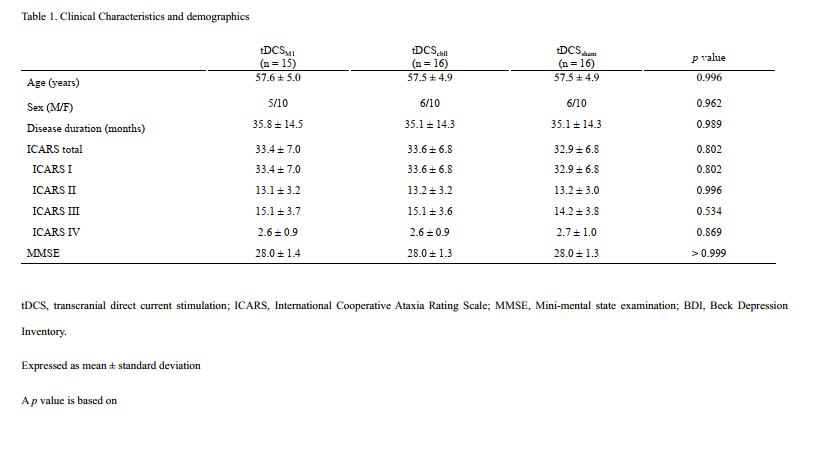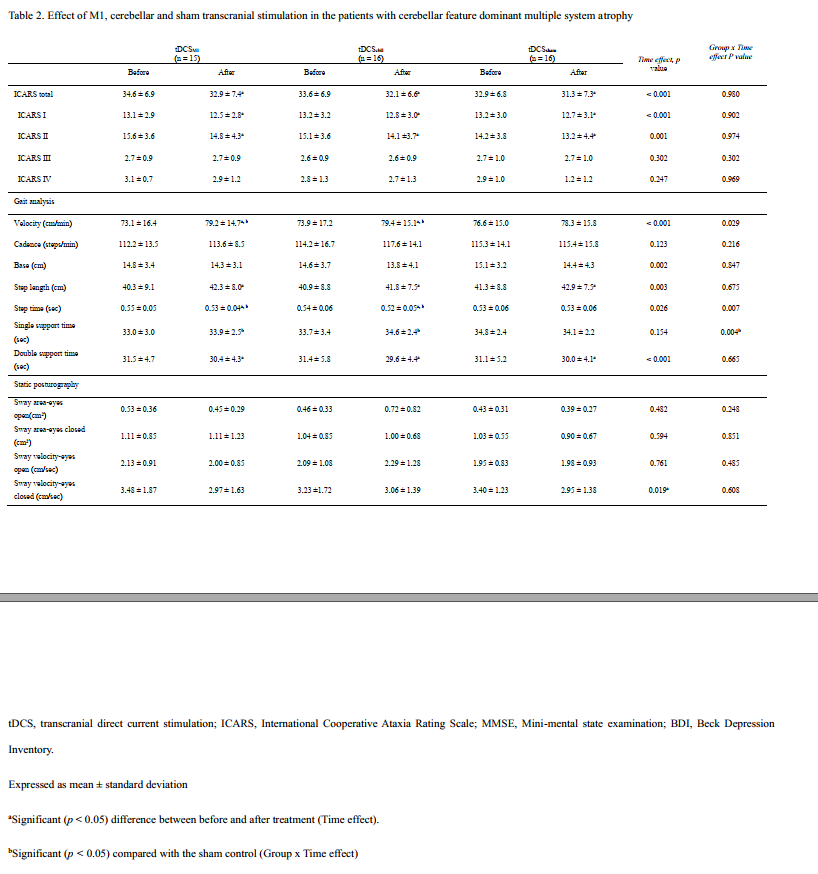Objective: The aim of study is to investigate an effect of a transcranial direct current stimulation (tDCS) on the primary motor cortex (M1) and cerebellum for patients with cerebellar dominant multiple system atrophy (MSA-C).
Background: Transcranial direct current stimulation (tDCS) is one of the non-invasive brain stimulation technics which modulate neuronal activity depending on polarity and stimulation site. There is controversy over the effect of tDCS for the degenerative cerebellar ataxia, especially for the MSA-C.
Method: We recruited the probable MSA-C patients and performed 3 weeks, sham-controlled, randomized, double blinded, cross-over clinical trial. All enrolled subjects were received 3 times of single section tDCS on every single visit in random order (M1, cerebellum or sham). Blinded raters assessed clinical scales including International Cooperative Ataxia Rating Scale (ICARS), Mini-mental state examination and Beck’s Depression Inventory (BDI) before and immediately after the stimulation. Gait and static balance tests using the GAITRite walkway system and DIERS Pedoscan system were conducted, as well.
Results: Total 16 participants were randomized, and one participant was dropped out at the third visit. ICARS total scores were improved after the single section of tDCS treatment, regardless of stimulation site (p < 0.001). However, the amount of improvement by M1 and cerebellar stimulation were not significantly higher than the sham stimulation (p = 0.980). In gait analysis, the gait velocity and step time were significantly improved after the M1 and cerebellar stimulation and the changes were statistically meaningful compared with the sham stimulation (velocity, p = 0.029; step time, p = 0.007). The step length and double support time were improved after the M1 and cerebellar stimulation (step length, p = 0.003; double support time, p < 0.001), but they were not significantly differed from sham stimulation (step length, p = 0.675; double support time, p = 0.665). None of static posturography parameters showed significant differences in all three groups. None of participants had side effect or significant adverse effect after treatment.
Conclusion: The M1 and cerebellar tDCS for the patients with MSA-C showed effect on improvement of ICARS, gait velocity and step time. Further studies are needed to figure out the standardized protocol for maximizing the effect of tDCS in MSA-C.
To cite this abstract in AMA style:
JH. Ahn, J. Song, I. Choi, DY. Lee, JW. Cho, WH. Chang, J. Youn. Cerebellar tDCS for multiple system atrophy cerebellar: Double blinded, randomized, sham-control, cross-over study [abstract]. Mov Disord. 2021; 36 (suppl 1). https://www.mdsabstracts.org/abstract/cerebellar-tdcs-for-multiple-system-atrophy-cerebellar-double-blinded-randomized-sham-control-cross-over-study/. Accessed December 20, 2025.« Back to MDS Virtual Congress 2021
MDS Abstracts - https://www.mdsabstracts.org/abstract/cerebellar-tdcs-for-multiple-system-atrophy-cerebellar-double-blinded-randomized-sham-control-cross-over-study/


